Abha
© Thomas Wilson Shawcross 13 April 2005 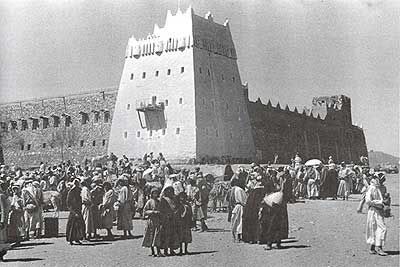
This vintage photograph shows a fort near Abha
In the year 1419, I had the good fortune to travel to Abha. This was unlike my typical travel experience. Usually, I have some notion of where I want to go, and what I will do and see when I get there. All that I knew about Abha was that it was located high in the mountains of Saudi Arabia, about a mile-and-a-half above the level of the Red Sea, and so it would be cool there. Having worked one week in Riyadh, where temperatures had never dropped below 38° Celsius (100° F), “cool” was all I needed to know about Abha.
1419 was a good year for travel in Saudi Arabia. No, “1419” is not a typo, it was the “official” year that I was there, and it was three full years before the tragic events of 1422 (to be specific, of Sept 11, 2001 if one reckons time by the Gregorian calendar instead of the Islamic (Hijri) calendar).
I live in South Florida, so it is not as if I am a stranger to heat, but Saudi Arabia definitely “raises the bar.” Earlier that week, my client (the son-in-law of a Sheik), had driven me to my hotel at 11:30 pm, after we had feasted on roast goat at a Riyadh restaurant. His limo had one of those gauges that displayed the outside temperature. It was 115° F!
I never knew how hot it got in Riyadh during the day. The local radio stations never reported on the temperature. One of the foreign-national workers told me that was due to a recent law that forbade working when the temperature rose above 140° F (60° C). I wondered if that were true. I did know that the “cold” water in my hotel room was significantly hotter than the “hot” water. At first, I had suspected that someone had incorrectly installed the handles in the shower tub, but even if that were so, shouldn’t one of the handles have provided cold water? I was informed that the “hot” water was kept at 120° F by a hot water heater, but that the “cold” water was kept in a storage tank on the roof, where it would get even hotter than the hot water.
So, when my client suggested a weekend visit to Abha, which was considered to be a Saudi resort town because of its cool temperatures, I booked a seat on the first flight leaving Riyadh on Wednesday evening.
No, “Wednesday” is not a typo. The Saudi “weekend” is on Thursday and Friday. The gift shop in my hotel at Riyadh sold t-shirts emblazoned with the letters “TGIW” (and an image of a sunglasses-wearing camel lounging in a pool chair while sipping on a cold beverage – lemonade, I assumed – since alcohol was forbidden).
The flight to Abha was short but interesting. The Saudi airplanes project an in-flight image for the benefit of their passengers. The image points toward Mecca. Muslims are required to bow towards Mecca and pray five times a day. In the US, this direction is easy to determine – Mecca is solidly east of all parts of the US – but within the Kingdom of Saudi Arabia, Mecca could be in any direction, depending on which direction the airplane was flying, and how long it had been airborne. So, a graphic symbol is continually projected inside the cabin where the passengers can easily view it, and the symbol always points to Mecca. I am not being coy by not revealing what the symbol was – in truth, I have sort of forgotten. I think it might have been a crescent moon.
I remember being excited at the prospect of what I might see in Abha. After all, I had never heard of Abha prior to buying a ticket to go there, and I had not had the opportunity to do any research. Who knew what might lie around the next bend? That soon turned out to be a question I considered over and over again, as my taxi driver sped around the hairpin curves of the road leading from the Abha airport to the InterContinental Hotel, which was located atop a mountain overlooking Abha. At every blind curve, my taxi would swerve across the centerline and into the lane of what would have been the oncoming traffic. Fortunately, there never was any oncoming traffic on the 20 km drive, or you wouldn’t be reading this story now.
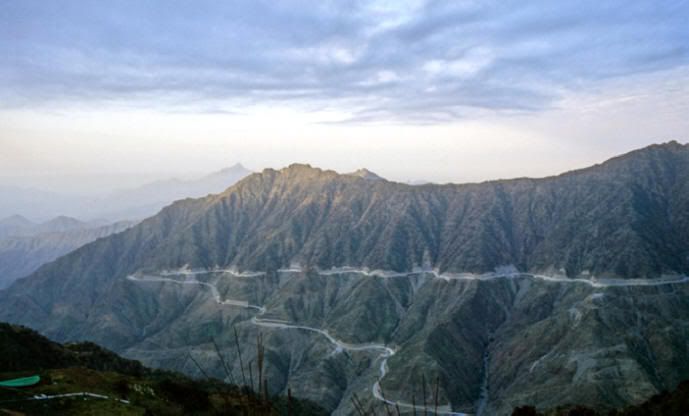
The road to the InterContinental Hotel
Note the large dome on the Abha InterContinental Hotel
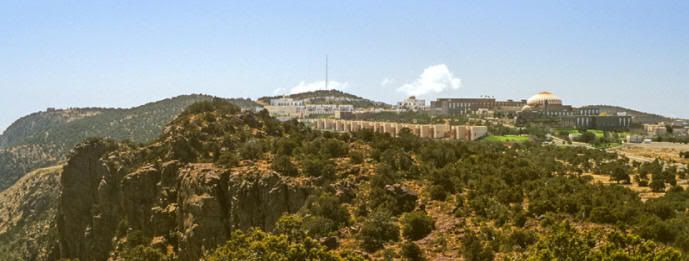
Everything about the Abha InterContinental Hotel was grand. It looked as if David Macaulay had designed it. It may have seemed even larger than it was, because there were so few guests while I was there. I later found out that the hotel makes its money on huge conventions, and between times it is relatively unoccupied. But the hotel was designed on a truly enormous scale – the hallway leading to my room was wider than the road leading to the hotel (and it had no hairpin curves).
The hotel is surrounded by a National Park. I was concerned that I could get lost wandering about the hotel, so I decided to venture into the seemingly smaller confines of the National Park. I discovered there was a tramway nearby, so I decided to check it out.
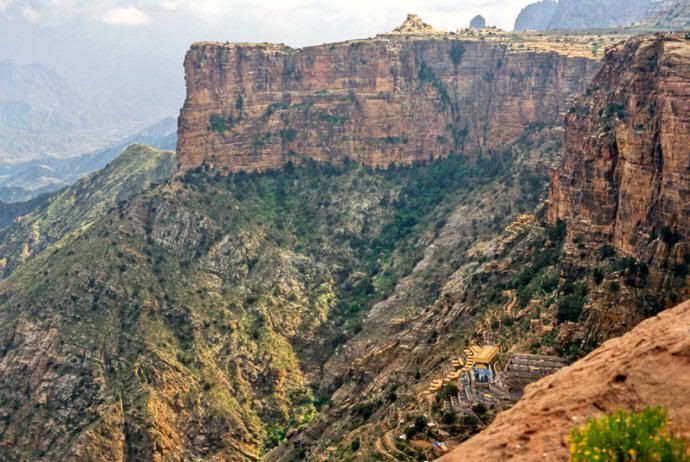
The tramway went down the cliffs that border the plateau on which Abha was built. At the bottom of the tram ride there was a small village, built seemingly on the cusp of the cliff. One misstep and that would be the last for anyone who resided there.
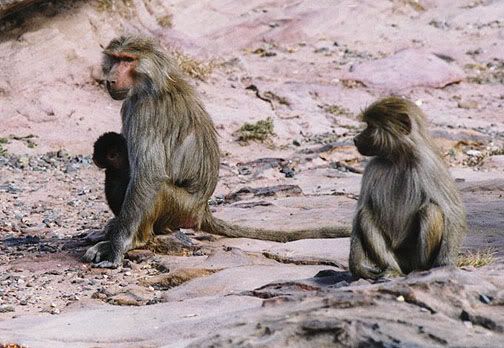
Curiously, the area abounded in Hamadryas Baboons. I noticed that many of the homes had barred windows, and I assumed they were for keeping out the baboons.
On the way back to my hotel, I hitched a ride with a very old Arab man who was driving a pickup truck. He seemed delighted to have a chance to practice his English on me.
The hotel and the National Park were nice, but now it was time to see the city. A taxi took me into town. All the way down, I hoped my previous driver wasn’t coming back with another prospective guest.
On the outskirts of the city, I saw several homes built of mud bricks and timber. It was an architectural style that was new to me, but it appeared to be an ancient one. I think the rows of timbers act to divert rainwater from the mud blocks.
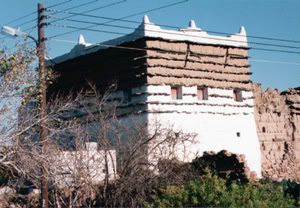
Abha Architecture
The city of Abha consists of about 156,000 inhabitants, and it looks like this, for the most part, but there are some interesting differences where the plateau of the city meets the dropping off places of the cliffs.

Abha
I walked around in the souks (markets) of Abha for a while.
I considered buying a souvenir Arab headdress, but I couldn’t think of any occasions when I would wear one, so instead I bought a shwarma sandwich.
Shwarma sandwiches look like overweight tortillas. They are very tasty!
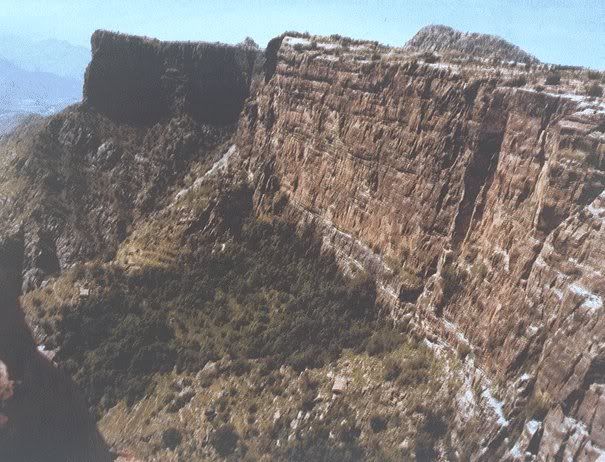
Cliffs border one side of Abha
I was glad I had gone to Abha. It was an interesting place, full of surprising sights. Also, it was cool. When the “weekend” was over, I headed on to Al-Khobar, which was nearly as hot as Riyadh and much more humid, as it sits alongside the Persian Gulf.
In Al-Khobar, I met a Palestinian man who knew all the Clinton – Lewinsky jokes, and a Saudi Sheik gave me some gold calligraphy framed on a black background – one hundred ways to spell “Allah” in Arabic script, but that’s another story.
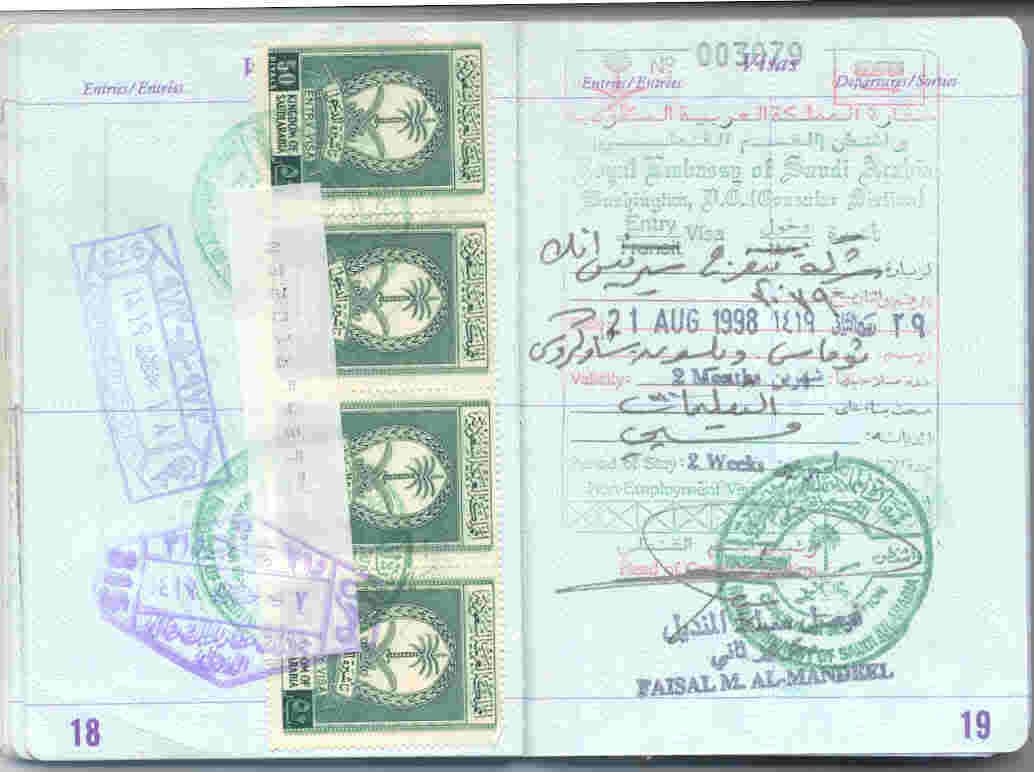
Above: Saudi stamps accompany my 1998 visa. Note that after “21 Aug 1998” it says “١٤١٩” which is 1419 in Indian Numerals. Saudis use Indian Numerals, not Arabic Numerals, but that's another story too.

This vintage photograph shows a fort near Abha
In the year 1419, I had the good fortune to travel to Abha. This was unlike my typical travel experience. Usually, I have some notion of where I want to go, and what I will do and see when I get there. All that I knew about Abha was that it was located high in the mountains of Saudi Arabia, about a mile-and-a-half above the level of the Red Sea, and so it would be cool there. Having worked one week in Riyadh, where temperatures had never dropped below 38° Celsius (100° F), “cool” was all I needed to know about Abha.
1419 was a good year for travel in Saudi Arabia. No, “1419” is not a typo, it was the “official” year that I was there, and it was three full years before the tragic events of 1422 (to be specific, of Sept 11, 2001 if one reckons time by the Gregorian calendar instead of the Islamic (Hijri) calendar).
I live in South Florida, so it is not as if I am a stranger to heat, but Saudi Arabia definitely “raises the bar.” Earlier that week, my client (the son-in-law of a Sheik), had driven me to my hotel at 11:30 pm, after we had feasted on roast goat at a Riyadh restaurant. His limo had one of those gauges that displayed the outside temperature. It was 115° F!
I never knew how hot it got in Riyadh during the day. The local radio stations never reported on the temperature. One of the foreign-national workers told me that was due to a recent law that forbade working when the temperature rose above 140° F (60° C). I wondered if that were true. I did know that the “cold” water in my hotel room was significantly hotter than the “hot” water. At first, I had suspected that someone had incorrectly installed the handles in the shower tub, but even if that were so, shouldn’t one of the handles have provided cold water? I was informed that the “hot” water was kept at 120° F by a hot water heater, but that the “cold” water was kept in a storage tank on the roof, where it would get even hotter than the hot water.
So, when my client suggested a weekend visit to Abha, which was considered to be a Saudi resort town because of its cool temperatures, I booked a seat on the first flight leaving Riyadh on Wednesday evening.
No, “Wednesday” is not a typo. The Saudi “weekend” is on Thursday and Friday. The gift shop in my hotel at Riyadh sold t-shirts emblazoned with the letters “TGIW” (and an image of a sunglasses-wearing camel lounging in a pool chair while sipping on a cold beverage – lemonade, I assumed – since alcohol was forbidden).
The flight to Abha was short but interesting. The Saudi airplanes project an in-flight image for the benefit of their passengers. The image points toward Mecca. Muslims are required to bow towards Mecca and pray five times a day. In the US, this direction is easy to determine – Mecca is solidly east of all parts of the US – but within the Kingdom of Saudi Arabia, Mecca could be in any direction, depending on which direction the airplane was flying, and how long it had been airborne. So, a graphic symbol is continually projected inside the cabin where the passengers can easily view it, and the symbol always points to Mecca. I am not being coy by not revealing what the symbol was – in truth, I have sort of forgotten. I think it might have been a crescent moon.
I remember being excited at the prospect of what I might see in Abha. After all, I had never heard of Abha prior to buying a ticket to go there, and I had not had the opportunity to do any research. Who knew what might lie around the next bend? That soon turned out to be a question I considered over and over again, as my taxi driver sped around the hairpin curves of the road leading from the Abha airport to the InterContinental Hotel, which was located atop a mountain overlooking Abha. At every blind curve, my taxi would swerve across the centerline and into the lane of what would have been the oncoming traffic. Fortunately, there never was any oncoming traffic on the 20 km drive, or you wouldn’t be reading this story now.

The road to the InterContinental Hotel
Note the large dome on the Abha InterContinental Hotel

Everything about the Abha InterContinental Hotel was grand. It looked as if David Macaulay had designed it. It may have seemed even larger than it was, because there were so few guests while I was there. I later found out that the hotel makes its money on huge conventions, and between times it is relatively unoccupied. But the hotel was designed on a truly enormous scale – the hallway leading to my room was wider than the road leading to the hotel (and it had no hairpin curves).
The hotel is surrounded by a National Park. I was concerned that I could get lost wandering about the hotel, so I decided to venture into the seemingly smaller confines of the National Park. I discovered there was a tramway nearby, so I decided to check it out.

The tramway went down the cliffs that border the plateau on which Abha was built. At the bottom of the tram ride there was a small village, built seemingly on the cusp of the cliff. One misstep and that would be the last for anyone who resided there.

Curiously, the area abounded in Hamadryas Baboons. I noticed that many of the homes had barred windows, and I assumed they were for keeping out the baboons.
On the way back to my hotel, I hitched a ride with a very old Arab man who was driving a pickup truck. He seemed delighted to have a chance to practice his English on me.
The hotel and the National Park were nice, but now it was time to see the city. A taxi took me into town. All the way down, I hoped my previous driver wasn’t coming back with another prospective guest.
On the outskirts of the city, I saw several homes built of mud bricks and timber. It was an architectural style that was new to me, but it appeared to be an ancient one. I think the rows of timbers act to divert rainwater from the mud blocks.

Abha Architecture
The city of Abha consists of about 156,000 inhabitants, and it looks like this, for the most part, but there are some interesting differences where the plateau of the city meets the dropping off places of the cliffs.

Abha
I walked around in the souks (markets) of Abha for a while.
I considered buying a souvenir Arab headdress, but I couldn’t think of any occasions when I would wear one, so instead I bought a shwarma sandwich.
Shwarma sandwiches look like overweight tortillas. They are very tasty!

Cliffs border one side of Abha
I was glad I had gone to Abha. It was an interesting place, full of surprising sights. Also, it was cool. When the “weekend” was over, I headed on to Al-Khobar, which was nearly as hot as Riyadh and much more humid, as it sits alongside the Persian Gulf.
In Al-Khobar, I met a Palestinian man who knew all the Clinton – Lewinsky jokes, and a Saudi Sheik gave me some gold calligraphy framed on a black background – one hundred ways to spell “Allah” in Arabic script, but that’s another story.

Above: Saudi stamps accompany my 1998 visa. Note that after “21 Aug 1998” it says “١٤١٩” which is 1419 in Indian Numerals. Saudis use Indian Numerals, not Arabic Numerals, but that's another story too.


1 Comments:
Intriguing memoir. Makes me want to visit Abha over the weekend :)
-Freeda
(Jeddah)
Post a Comment
<< Home